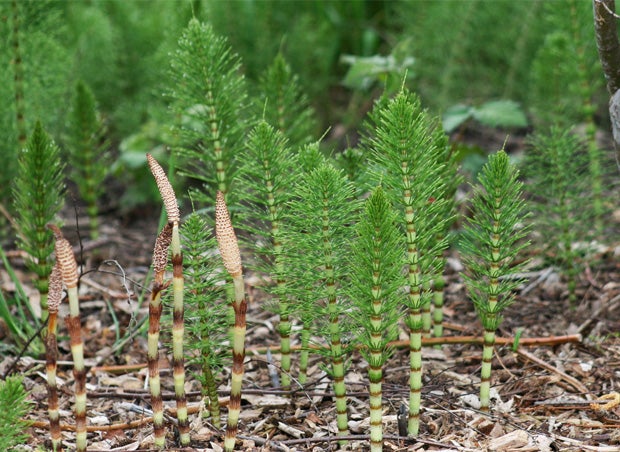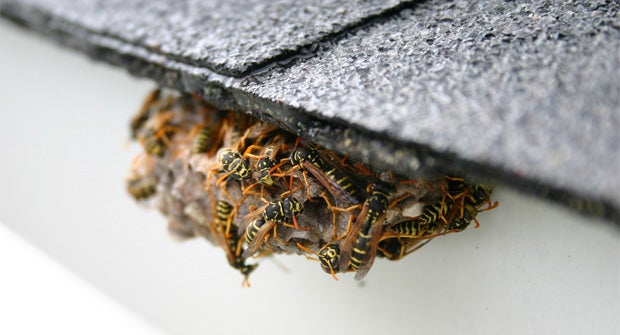An ancient weed known as “horsetail”
ListenThis week, Mike explains why you should leave your tree bases bare, how to get your blueberries to thrive, why plants should not be handled after it rains, the reason to keep kitchen scraps out of your garden, how to get rid of yellow jackets without chemicals, and how to get rid of horsetail weed.
Question of the Week:
Mike: I’ve been an organic gardener since before you started editing ORGANIC GARDENING magazine. (McG here: that was back in 1990.) But now I’m so bothered by a weed called horsetail that I’m thinking about giving up gardening! I have already mowed over my perennial garden because of this weed and sifted the roots out of the soil by hand. (Not easy for a lady approaching 70.) Now that my new plants are in, I go out daily and pull, pull, pull.
This weed is the worst I’ve ever dealt with. It spreads underground and via spores. I have read that I might be able to get rid of it if I solarize my soil for one summer, but I have a beautiful, productive asparagus patch as well as rhubarb and blueberries in the area.
I went to my extension service for advice; they have the same problem in one of their gardens! I’ve tried cardboard, newspaper and multiple types of deep mulch without any luck. And this weed seems to love weed block, sending out its invasive roots along the edges and poking through the fabric in less than a season.
I garden in cool USDA Zone 5 and have a nice sandy loam soil supplemented annually with home-made compost and purchased lobster compost. I use liquid fish fertilizer when needed and water deeply and infrequently. If you have any ideas about how to get rid of horsetail I would really love to hear them. Thank you!
— Sally in coastal Maine (less than 100 miles south of Canada)
Learn how to get rid of horsetail weed »
-

Horsetail Weed. Photo by Flickr user born1945
Highlights from show for July 20, 2013:
Resist planting at the base of your trees
Bob in Santa Barbara, California has a patch of ground that gets plenty of shade under a large cedar tree and wants to know what he can safely plant in that area. Mike advises against it, explaining: “It sounds like you have an incredible specimen of a fabulous evergreen tree, and you are risking harming it by constantly digging around the root system. I think you are taking very foolish risks for absolutely no good reason. If you look in nature, for instance, the area underneath a tree is always barren…”
Don’t handle your plants after it rains
Sharon in Mount Airy, Pennsylvania wants to clear up the rumor for herself! Is it true that she shouldn’t harvest any plants when they’re wet, such as during or after raining. “Here’s the deal, technically if you want an overall rule, don’t handle plant leaves when the leaves are wet… they are very sensitive to being worked when the leaves are wet,” Mike clarifies.
Blueberries thrive in acidic soil
Dan in Waterbury, Connecticut has some blueberries planted in a row between rose buses and doesn’t know why they are not doing well or bearing any fruits. “Roses are not acid loving plants,” Mike explains. “Blueberries crave so acidic a soil that we grow them in a dedicated area where we can keep the acid levels of the soil so low that other plants would die off.”
-

Photo by Flickr user Martin Stone
Kitchen scraps don’t offer much — if any — nutrition to your compost
Lois was thinking about blending and liquefying raw organic vegetable scraps for her garden in Center City, Philadelphia and wanted to know if it’s a good idea. Mike says: “The simple answer is yes. you would not want to use orange or lemons or limes or anything like that. But there are two problems here, you’re not adding much, if any, nutrition to your plants. The only things that cycle through your kitchen that have plant feeding capabilities are coffee grounds, egg shells, (and legumes). And I would worry about vermin.”
Don’t till your raised beds
Mistakenly, Rob in Claymont, Delaware was tilling his raised beds when he found vines in it everywhere. “I don’t think it’s going to be a problem unless you see actual plants coming up out of the raised beds,” Mike says. “In the future the most important thing is you need to put an inch or two of fresh compost or well aged mushroom soil on top because your plants need some nutrition, and no more tilling!“
Two ingenious ways to kill yellow jackets without using chemicals
Thomas from Dothan, Alabama concrete block shed infested with yellow jackets and has been unsuccessful in removing them with chemical sprays. Mike explains that yellow jackets are very aggressive and territorial, and the best way to get rid of them is to use their hostile nature against themselves. Mike shares two methods:
- “Yellow jackets are least aggressive at night, so you have to do all of your set up at night. Due to a unique factor in their sight, you can use flashlights if you cover them with red cellophane. They can’t see that color spectrum. And obviously you want to move slowly and you’re hoping for a cool night. … If you can get one or two bug zappers out to the area … and hang them near where they go in and out of the wall of the shed, then in the morning, they will see this thing and attack it. And of course the ones that attack it will be zapped. Well the entire colony will get in line to leap to their doom inside the frying jaws of this machine. … Within 48 hours, they’ll all be dead.”
- “The other option is to use a shop vac. Get the hose of a shop vac near … a doorway they go in and out all the time, their own little entrance hole. … In the morning when they start to be active, turn the shop vac on. They will attack the shop vac from the noise it’s making, and they will all be sucked to their doom.”
-

Yellow jackets building a nest. Photo by Flickr user Matt & Nicole Cummings
Zoysia grass is the solution for a high traffic lawn
Michael from Cherry Hill, New Jersey is calling Mike for guidance in developing better aeration for his high traffic lawn. Mike suggests that rather than struggle with aerating his cool-season lawn, his energy would be better spent installing a grass that could hold up against the traffic in the first place.”You could grow Zoysia grass out there. That’s a warm-season grass you would install in the spring, I think it’s the grass that would take the dogs and the kids best. … In the spring, rather than aerate, you would till everything up, rake away as much of the green as you could, put down that inch of yard waste compost and then install your Zoysia grass plugs.”
— This week’s post was written by Jolie Higazi, You Bet Your Garden Intern
WHYY is your source for fact-based, in-depth journalism and information. As a nonprofit organization, we rely on financial support from readers like you. Please give today.

